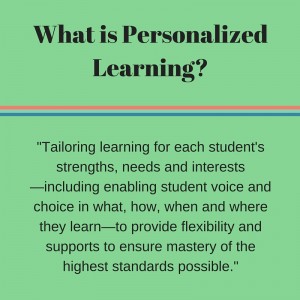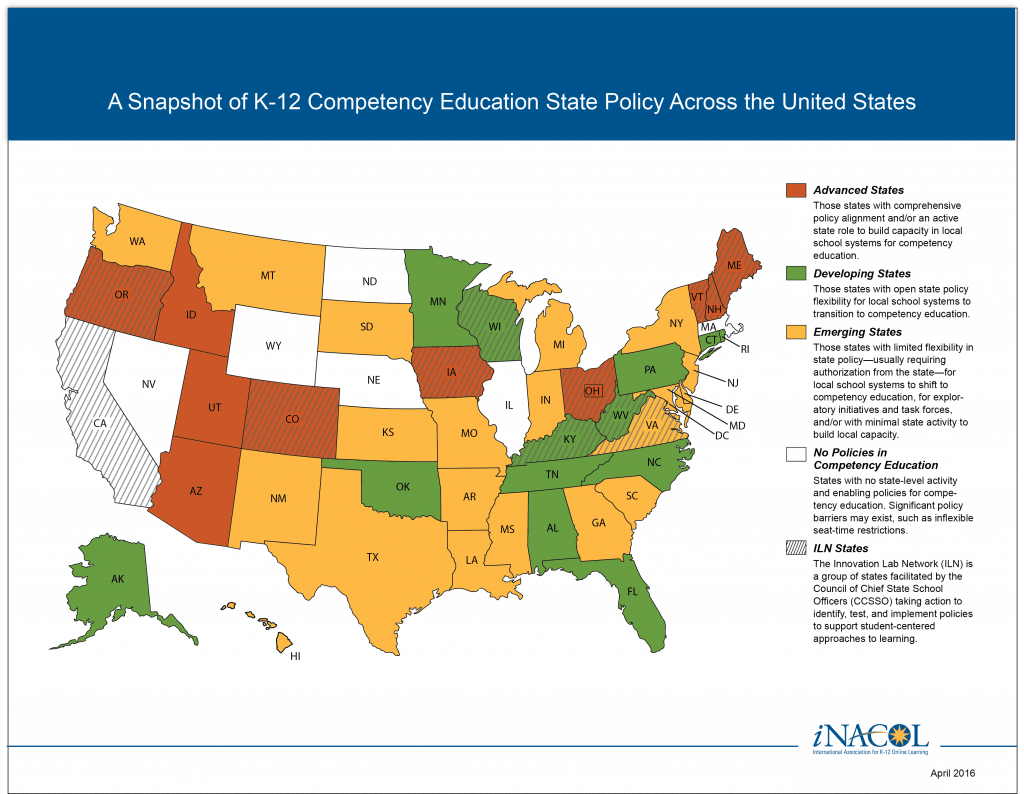Moving from Seat-Time to Competency-Based Credits in State Policy: Ensuring All Students Develop Mastery
Education Domain Blog
 School leaders find once they begin to optimize their instructional models using anytime, anywhere learning, state policies that reinforce seat time become a barrier to innovative approaches delivering highly-personalized learning experiences for all students.
School leaders find once they begin to optimize their instructional models using anytime, anywhere learning, state policies that reinforce seat time become a barrier to innovative approaches delivering highly-personalized learning experiences for all students.
Personalized learning is important because it holds the promise to create student agency, preparing all students for college, career and life. In these learning environments, students tailor their education based on their own interests and passions. Students co-design their learning plans, engage in meaningful learning experiences to accomplishing college- and career-ready goals, and take ownership of their education.
Educators offer tailored instruction targeted to each student’s needs and empower students to learn standards, skills, and competencies by exploring topics relevant to them. For example, a student interested in biotechnology could develop an interdisciplinary approach that covers both biology and chemistry standards and work in a biotechnology internship part-time.
It is important to challenge seat-time as the only way to earn credit toward graduation. Education systems should focus on learning (what a student knows and can do) and enable students to earn credits based on demonstrated mastery.
When students only earn credits based on the number of minutes in a course for a specific subject, it limits the ability for learning after school, in the community, through internships, and through online learning.
State policymakers can enable personalized, competency-based education that provides “open-walled” learning opportunities–inside and outside of school buildings–by allowing students to accumulate credits toward graduation by demonstrating competencies across disciplines.
Moving from “time-based” policies toward “competency-based” structures of earning credits based on demonstrated mastery is a major shift and is fundamental to personalizing learning at scale.
How States Can Rethink Seat Time with Credit Flexibility Policies
- Allow flexibility for schools to base student progression on demonstrated mastery of competencies, rather than on seat time
- Allow students to earn credit by demonstrating mastery of skills learned in class, online, and outside of school.
- Audit existing state statutes and regulation to identify policies that reinforce seat time.
Credit flexibility is a beginning, and necessary step, but the shift to learner-centered systems is a transformation and fundamental redesign of K-12 education. States can play an important role in capacity building to help school districts utilize credit flexibility policies to move toward highly-personalized education systems.
What Is Seat Time?
Seat time, or the Carnegie Unit, bases the awarding of academic credit on a defined minimum amount of instructional time in a subject area. The standard Carnegie Unit is defined as 120 hours, which translates into one hour of instruction per subject per day, for 24 weeks. Most public high schools use the Carnegie Unit and award students one credit for a course that lasts all school year and a half credit for a course that lasts a semester. Systems of instruction based on seat time are focused on ensuring minimum exposure to academic content rather than student mastery of the content.
State Examples of Credit Flexibility Policies
According to the Carnegie Foundation for the Advancement of Teaching, 42 states have created at least some flexibility for school districts to base academic credit on mastery rather than just seat time.
The CompetencyWorks map below shows the progression of states in advancing policies that enable and scale competency education, from no state policies to advanced policy frameworks.
In the iNACOL report When Success Is the Only Option: Designing Competency-Based Pathways for Next Generation Learning, state policy developments to advance competency-based pathways are grouped into three categories based on stages of maturity: waivers, credit flexibility, and redesign.
Seat-Time Waivers
“Seat-time Waiver” policies allow school districts to request a waiver from the state from seat time provisions for awarding credit. Waiver requests usually must illustrate why the school district is requesting the flexibility and how the district will award credit for graduation.
West Virginia is an example of a state that allows school districts to base course credit on mastery, but in order to do that, the district must obtain an approved waiver from the state.
West Virginia State Board of Education (WVBE) Policy 2510 states:
A county board of education that proposes to schedule class periods in a manner that results in fewer than 8,100 minutes of instructional time allotted for a high school course credit must obtain a waiver from the WVBE prior to implementing such a schedule.
Waivers are not ideal because they require districts and school leaders to make a bureaucratic appeal and require states to grant permission for a waiver. Credit flexibility is a better approach for enabling personalized learning because it offers a blanket policy to move away from seat-time, rather a one-time waiver which is essentially a request for permission.
Credit Flexibility
Credit Flexibility provides permission for schools and districts to develop alternatives to earning credit through seat-time, such as awarding credits based on demonstrated mastery of standards and competencies. These policies provide districts and schools with the ability to base credit on factors other than seat time. Credit flexibility ensures districts have allowable alternatives to seat-time awarding of credit.
Oregon has been, and continues to be, a leading state in credit flexibility and encouraging districts to award academic credit based on mastery rather than seat time. Since 2002, the state policies allow districts to award credit based on proficiency.
Oregon Administrative Code 581-022-1131 allows a school district or charter school to grant credit if a student demonstrates mastery by any one or more of the following ways:
- Successfully completing classroom or equivalent work designed to measure proficiency in class or out of class, where hours of instruction may vary;
- Successfully passing an appropriate exam designed to measure proficiency or mastery of identified standards;
- Providing a collection of work or other evidence which demonstrates proficiency or mastery of identified standards; and/or
- Providing documentation of prior learning activities or experiences which demonstrate proficiency or mastery.
Ohio is another good example of credit flexibility policies. In 2006, the Ohio legislature passed SB 311, which directs “the state board of education, in consultation with the Ohio board of regents…[to] adopt a statewide plan implementing methods for students to earn units of high school credit based on a demonstration of subject area competency, instead of or in combination with completing hours of classroom instruction.”
In March 2009, the Ohio State Board of Education adopted policies to further clarify and expand the state’s Credit Flexibility program. All school districts will allow students to earn credit by demonstrations of mastery by the 2010-2011 school year.
From Seat-Time to Competency-Based System Redesign
Competency-based “redesign” policies are comprehensive and begin with offering credit flexibility but provide an advanced state policy framework that result in building capacity across the systems to support competency-based pathways. Advanced redesign in moving from seat-time to competency-based education includes redefining how students earn credits by redefining the Carnegie Unit into specific standards and competencies. The focus on mastery eliminates definitions of credits by seat-time and states re-examine all existing state policies that are rooted in seat-time so that districts can move toward learner-centered approaches.
New Hampshire is the most advanced state to move fully down this path. Credits are based on students’ mastery of competencies.
In 2013, coordinating with educators from across the spectrum along with the National Center for the Improvement of Educational Assessment and The Center for Collaborative Education, the Department developed state-level competencies to support and build capacity for local school systems. The state has approved competencies in mathematics, English language arts, science, art, and work-study practices. The Work-Study Practices emphasize cross-cutting competencies such as communication, creativity, collaboration, and self-direction. Each school district adopts its own competencies.
Below is an example of New Hampshire state-approved competencies in mathematics that are derived from the state’s academic standards:
New Hampshire’s approach is designed around three themes:
- Personalization;
- Students as active learners; and
- Choice and flexibility for where and when learning occurs.
States leading competency-based redesign work redefine Carnegie Units or credits as competencies aligned to state academic standards and also include important skills and dispositions, such as lifelong learning competencies, communication and problem-solving skills.
Experience in pioneering states has shown that simply allowing for flexibility in state policy is not enough to catalyze personalized learning at scale. In both Oregon and New Hampshire, significant advances only occurred after the state took a more direct, supportive, enabling role, by setting up task forces, investing in pilots, providing professional development, setting up regional networks, and providing technical assistance to districts and schools to build educator capacity.
States will need to create intentional strategies to build educator capacity in partnership with school districts if they are to scale personalized, competency-based learning environments.
Credit flex and advanced redesign toward competency-based systems are important pathways for state policymakers to consider on the road to transforming and aligning the system toward student-centered learning.
Interested in other promising policies for personalized learning? See our other resources and blogs in this series:
- New Blog Series: Promising Policies for Personalized Learning
- Education Innovation Pilot Programs Provide Catalyst for Localities Personalizing Learning for K-12 Students
- Competency-Based Education Task Forces: A State Policy Mechanism to Foster Personalized Learning By Creating Dialog, Surfacing Barriers and Providing Solutions
- Innovation Zones: Creating Policy Flexibility for Personalized Learning
- iNACOL report When Success Is the Only Option: Designing Competency-Based Pathways for Next Generation Learning
- CompetencyWorks report Cracking the Code: Synchronizing Policy and Practice for Performance-Based Learning
- CompetencyWorks report It’s Not a Matter of Time: Highlights from the 2011 Competency-Based Summit
- CompetencyWorks report Necessary for Success: A State Policy Maker’s Guide to Competency-based Education

